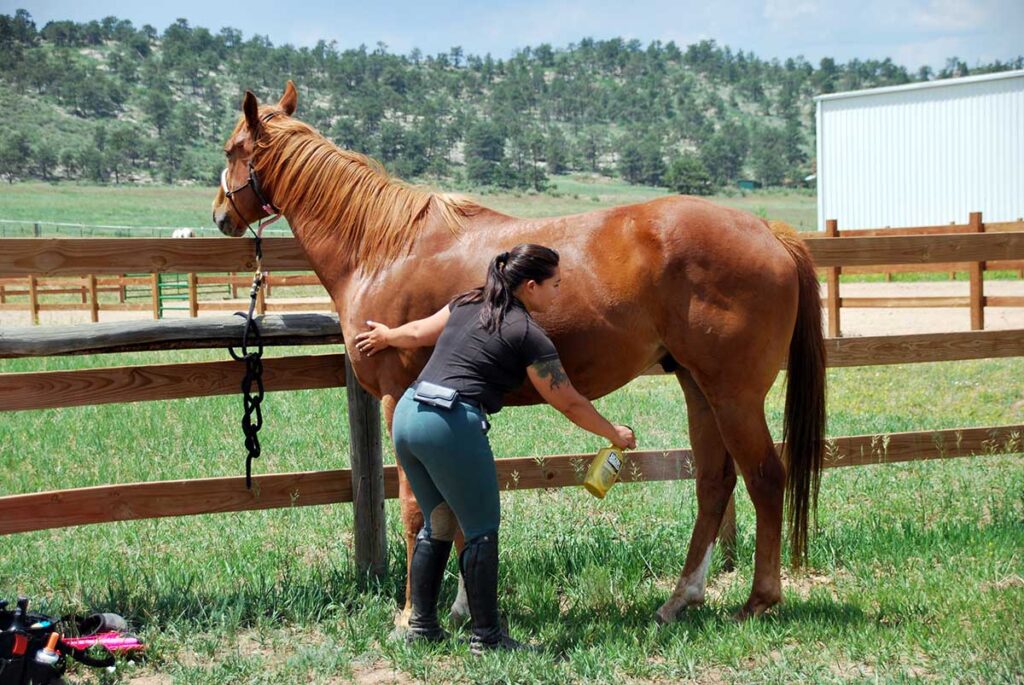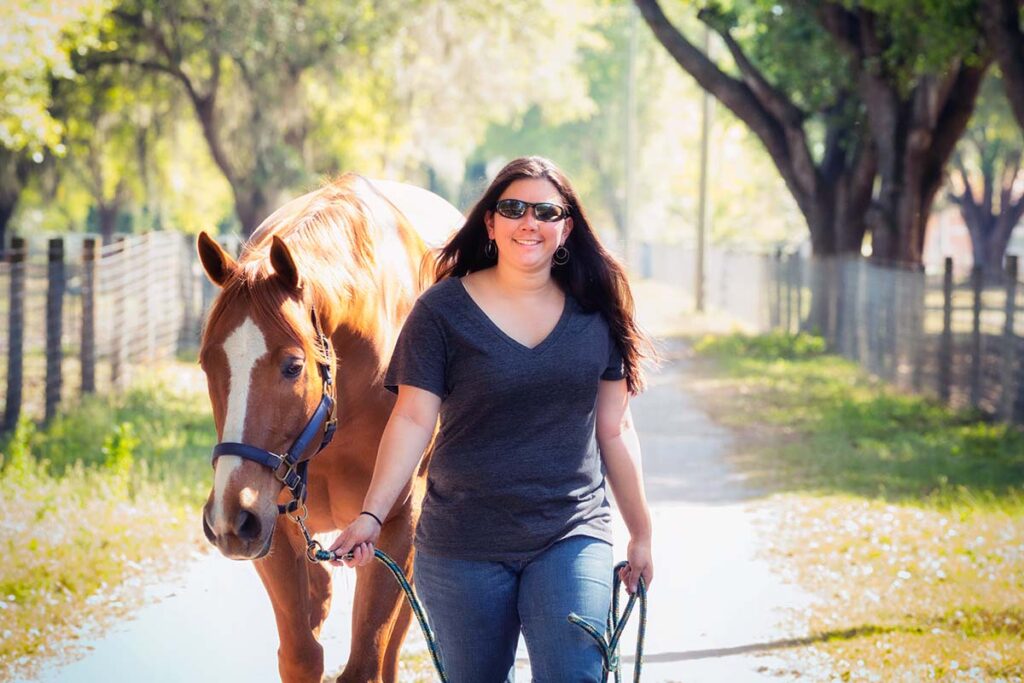Welcome to the wonderful world of horse ownership! As a new horse owner, you are embarking on an incredible journey of companionship, trust, and adventure. But before you swing a leg over or hit the trails, spend time getting to know your new horse. There’s a list of things you’ll need to tick off to ensure he has a smooth transition into his new life and home. We’re here to guide you through welcoming a recent purchase or adoption with his health and mental wellness in mind.
General Horse Health and Wellness
Exactly how well and how long it takes a new horse to settle in will depend on factors such as his health status, temperament, and previous care, said Jenny Biehunko, DVM, Res. ACVB, a veterinarian and behaviorist based in Birmingham, Alabama. That said, there are some basic guidelines for getting to know your new horse you’ll want to follow in the first few weeks of his time in your care.
If your horse has traveled over state lines, he likely came with a health certificate and proof of Coggins test indicating he’s negative for equine infectious anemia. Also ask for his health records to verify he’s up to date on vaccinations. Even if you know a horse’s health history, you should quarantine a fresh arrival from resident horses for at least three weeks to minimize the risk of disease transmission, Biehunko said. Horses shouldn’t be able to touch noses, but it’s best if they can see other equids to help satisfy their social need for herdmates.
Use this quarantine period to start gathering important information about and getting to know your new horse.
“Check his temp daily—a normal temp is 99-101.5 F,” Biehunko said. “It is helpful to have someone feed something tasty while you check the temp so the horse has a good association with this.”

His baseline temperature is a vital sign you need to know for future reference. And, by checking daily for fever, you can catch infectious disease early. Other vital signs to note about your new horse include his:
- Respiratory rate (normal for an adult horse is 10-24 breaths per minute);
- Heart rate (normal for an adult horse is 28-44 beats per minute);
- Capillary refill time (the time it takes for capillaries in the gums to return to pink after you’ve pressed them with a finger; if longer than 2 seconds, your horse might be dehydrated); and
- Gut sounds.
“If possible, set up a camera and get video or watch the horse’s behavior when no one is around, because horses tend to hide illness and may not exhibit behavioral signs if someone is physically present,” she said. “Also, remember the importance of understanding normal equine species-specific behavior and needs in order to be able to identify signs that something is wrong and to provide your new horse with outlets for behaviors that he has an innate need to express, especially during the quarantine period where he may be more isolated and confined than is ideal.”
Essentially, she said, horses need:
- Herd and/or barnmates. “Horses are herd animals,” Biehunko said. “They depend on the herd for survival. There is no way for us, as humans, to be a surrogate or make up for lack of conspecific company.”
- The ability to “graze,” even if it’s not necessarily on pasture. “Horses are trickle feeders,” she said. “They are meant to graze on lower concentrate browse for most of their awake life. They are also meant to move around as they eat.”
- The ability to look around and move. “Horses are prey animals, and their main defenses are the ability to look around and the ability to run. A confined horse may feel very vulnerable, especially if he is in a new environment and away from his herd.”
So what does this look like during a new arrival’s quarantine period?
“In most cases, having a safe turnout area where he can move around and see other horses but not touch noses is ideal,” Biehunko said. “He should have adequate, low-concentrate forage available at all times, if possible. This may involve slow feeders/haynets or food puzzles/toys, especially if he must be confined to a stall. If he cannot see other horses, a stall buddy of another species may be in order. Sometimes a mirror (safely installed in an area where it cannot be reached and broken) can help.”
She said horses without the opportunity to express these species-specific behavioral needs are at higher risk of developing health and behavioral issues (including stereotypical behaviors such as cribbing or stall walking), which can negatively impact their mental health.
Work and exercise can be an important part to keeping horses’ minds busy. Biehunko said it’s best to listen to the horse to determine when to start working in his new program.
“Is the horse used to daily exercise and will be confined?” she asked. “If so, it’s very important for the horse to move around and to get mental stimulation. Start at liberty and see if he stays with you and engaged.”
Once a horse has cleared quarantine, he can move into the next phase of his new life—joining his herdmates and barnmates and getting down to the normal routine.
Podcast: New Horse, New Problems
Diet Dilemmas

A horse’s diet is key to maintaining overall health and wellness. Even small deviations from normal can cause significant issues in some equids. As such, planning how to manage a new horse’s feeding regimen is one of the most important parts of getting him settled.
“Anytime an animal is stressed or there is an abrupt change, the risk of adverse health effects increases,” said Krishona Martinson, MS, PhD, a professor and equine extension specialist at the University of Minnesota, in St. Paul. “Moving locations, especially when accompanied by an abrupt diet change, substantially increases the risk of issues, including colic.”
The key is keeping the microbes in the horse’s gut happy during diet changes, she said. “Microbes are specialized to help digest specific feed types. When an abrupt diet change occurs, the microbes have no time to adjust to the new feed source and die. This mass die-off releases toxins which can cause issues like colic. Stress from a move can amplify these health issues.”
If you plan to adjust the forage in your new horse’s diet, the best way to avoid such turmoil is to secure a 10-14-day supply of the horse’s current hay and make the transition over that period, Martinson said. If you can’t acquire existing feed, she recommends finding a product that matches as closely as possible. Then, monitor your new horse for signs of digestive upset.
“Try to avoid substantial changes in hay types,” she said, “for example, switching cold turkey from grass to alfalfa hay.”
And don’t forget about the other forage in many horses’ diets: pasture. This is especially true for horses moving from areas with less grass—desert, smaller acreages, or more urban areas, for instance—to locations known for more lush pastures, such as Central Kentucky.
“Even if the horse is acclimated to pasture, owners should reacclimate the horse to new pastures,” Martinson said. “Start with 15 minutes of pasture access on Day 1. Add 15 minutes each day until five hours is reached, then continued access to pasture can occur if space allows.”
Finally, while brands sold nationally have made switching grain and supplements easier overall, owners might not have access to various local, regional, or even international (in the case of imported horses) products. Similar to forage changes, Martinson recommends having a supply of the horse’s current feed, if possible. You can then make adjustments slowly over 10 to 14 days if you’re switching to a different product.
“If the current grain product cannot be purchased in the new location, any new product should be slowly introduced over the course of 10 to 14 days,” she adds.
These slow and calculated diet changes help give the microbes time to adjust. They also reduce the risk of a mass die-off and, thus, the potentially serious issues that can accompany it, Martinson said.
Another change your new horse will have to contend with is a new water source. Arguably the most important part of the equine diet, you’ll want to pay close attention to hydration status.
An average 1,000-pound horse requires about 8 to 10 gallons of water daily. Horses that don’t drink enough can develop potentially serious issues, including poor performance, diminished organ function, and, of course, colic.
Some horses will drink just about anything, regardless of whether they’re at home, traveling, or just arriving at a new facility. Others are more finicky about their water. Martinson said owners can take steps to help encourage horses to drink, including:
- Keeping water between 45 and 65 F, which studies have shown can encourage horses to drink.
- Flavoring water with a variety of additives, such as apple cider vinegar or molasses. She also said washing buckets with a minty mouthwash helps some horses consume more water.
- Adding table salt or electrolytes to water to help trigger a horse to drink.
- Trying commercial water additives designed to increase horses’ consumption.
Finally, always consider gastric ulcers when getting to know a new horse and helping him settle in. Ulcers and ulcer development can worsen due to stress, which we know horses typically experience during a move. Biehunko recommends monitoring horses for signs of ulcers, such as poor appetite and flank watching/nuzzling. In horses with a history of ulcers, she adds, consider a preventive product, such as UlcerGard (omeprazole), to keep new issues from arising. If your veterinarian diagnoses your new horse with ulcers, he or she might prescribe GastroGard (a different dose of omeprazole) to treat the ones that develop.
Climate Considerations
Today, transporting horses is a much easier process than it was in the past. But this also means horses can travel longer distances to new homes that might be in very different climates than they’re used to.
“Horses tend to adjust better to cold than heat,” said Biehunko.
If introducing a new horse to a hot climate, take precautions. This might include providing a barn-safe fan, hosing with cool water, and ensuring continuous access to fresh, clean water. Also, make sure your horse sweats properly as he’s adjusting to a warmer climate. Anhidrosis (the inability or reduced ability to sweat) can go unnoticed in cooler climates but could be a serious problem in hotter, more humid ones.
If you’re welcoming a horse to a cooler climate and plan to blanket right away, ask the previous owner about the horse’s blanketing history, and proceed accordingly. Use positive reinforcement to help horses that aren’t familiar or have issues with blanketing become comfortable.
Build a Relationship

Once you’ve met your new horse’s health, wellness, and diet needs, it’s time to start building the relationship that will carry you into the future. While getting to know your new horse, spend time learning about his normal behaviors, quirks, likes, and dislikes. Watch his body language as you’re working with him at liberty in a small enclosure, Biehunko said. This can help you determine what he enjoys (scratches on the withers, face rubs, or playing with different objects, for example).
She encourages owners to use positive reinforcement training (giving the horse a reward for doing what we want or ask him to do) as they’re building a relationship.
“Do not punish or force handling that he doesn’t like if you don’t have to,” she said. Rather, “put a pin in it, and use positive reinforcement to desensitize and counter condition” when issues arise.
“I am a huge fan of positive reinforcement training,” Biehunko adds. “This can be anything: tricks, targeting, etc. Horses usually enjoy it, and it is a great way to form a positive association with their new owner and new environment. It helps to engage their brain and make them less worried.”
Finally, she said, give your new horse a chance to engage in species-specific behavior. Yes, you might want to spend every waking minute fawning over your new arrival. But remember, he needs time to be a horse, graze and socialize with equine friends, and interact with other barnmates.
Even once you’ve developed a positive relationship with your horse, don’t forego these important interactions. Keep scratching his withers, spending time grooming if he enjoys it, and doing groundwork to keep developing that bond.
Take-Home Message
Welcoming a horse to the family is exciting for everyone involved. To make the process as seamless as possible, take time getting to know your new horse. By paying close attention to his health and wellness during the transition, ensuring smooth diet adjustments, and taking time to develop a positive relationship with your new horse, you’re off to the best possible start for a perfect partnership.
This article originally appeared on TheHorse.com.
Are you enjoying this content? Sign up for My New Horse’s FREE newsletter to get the latest horse owner info and fun facts delivered straight to your inbox!








